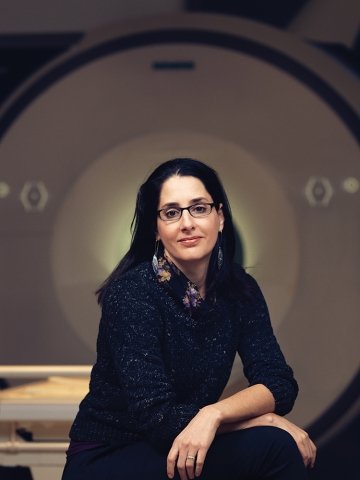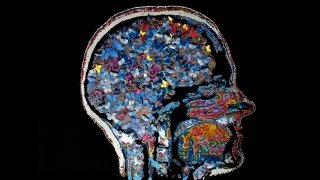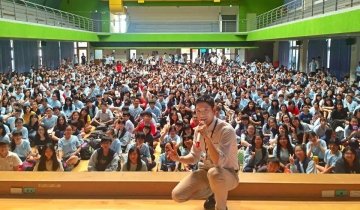Two decades ago, Mary Helen Immordino-Yang was a novice science teacher at a racially diverse junior-senior high school outside Boston when an inquisitive student launched her on an unexpected journey. After a shaky start to a unit on evolution, her seventh graders were finally warming to the topic of early humans.
But after showing some films about hominid origins, Immordino-Yang could tell that something was troubling the class.
The problem became clear when one of her African-American students spoke up. “Why do they always show early humans as Black?” the student asked.
In the highly diverse class where racial and ethnic relations had been strained, some students clearly thought the portrayals were racist. Immordino-Yang responded by plunging into the science: that humans originated in Africa where the equatorial sun caused adaptations, such as dark skin, to help block ultraviolet rays. As she talked about photons, pigmentation and DNA, she recalls, “I could see the lightbulbs going on.
They were beginning to see that basic scientific principles were a source of explanation for this really deep problem that was socially important to them.” For the middle schoolers, that discussion triggered a deeper engagement in learning and with one another. For Immordino-Yang, it was eye-opening. Why, she wondered, did an emotional connection to the course material make such a difference?
Social-emotional imagination

PHOTO BY CODY PICKENS.
“Science was a tool for understanding something deeply relevant to their experience as a person,” Immordino-Yang, a USC Rossier professor of education, psychology and neuroscience, says. “The role of sociality and meaning-making in human development: That’s what my work has been circling around ever since.”
She left teaching after two years when she was admitted to the Harvard Graduate School of Education, earning a master’s degree in education in 1998 and a doctorate in human development and psychology in 2005. In 2006, she moved to USC as a postdoctoral fellow at the Brain and Creativity Institute, directed by USC Dornsife Professor of Neuroscience Antonio Damasio, and quickly began to make inroads with research on the neurobiology of social emotion and its impact on adolescents’ academic learning and development.
“A decade later, it is apparent that Mary Helen created a new field within neuroscience,” Damasio said recently. “It can be properly called the neuroscience of education.”
Over the past decade her work has garnered prestigious awards, including the Cozzarelli Prize from the National Academy of Sciences and early career awards from the American Association for the Advancement of Science and the American Educational Research Association. In spring 2018, she received the Midcareer Grant from the Spencer Foundation.
Currently, Immordino-Yang is analyzing data from a study involving 500 ninth and 10th graders at Artesia High School that focused on adolescents’ “social-emotional imagination” — the ability to think meaningfully about their present and future selves, which research suggests is crucial to academic achievement and success in later life.
“Not a typical student”
Immordino-Yang, who grew up on a Connecticut farm, was herself not a typical student. She was bored and stressed in school, and with her parents’ blessings, she regularly traveled abroad, building boats with street children in Russia, studying in Ireland and documenting traditional boatbuilding in Kenya.
She also spent considerable time in France and learned French, Russian and Kiswahili. “I didn’t need to sit in geometry class. I’d just work through the book, come home and ace the final exam,” she recalls.
At Cornell University, she majored in French literature but had also pursued as much science coursework as possible — psychology, biology, physics, astronomy and other subjects. She dreamed of becoming a furniture maker, but a minor accident left her unable to work as a carpenter, and, out of desperation, she decided to try teaching. Massachusetts granted her a provisional certificate, and when she met her seventh graders, she knew she had found her calling. Her loves of science, culture and development all came together in the pursuit of answers to the complex questions of how people learn and how to educate.
Once she got to Harvard, this new pursuit blossomed.
Guided by Kurt Fischer, an expert on cognitive and emotional development, she studied two young men who had impressive learning and language abilities despite having an entire hemisphere of the brain removed to control severe epileptic seizures. She concluded that emotion and social interactions played crucial roles in reorganizing the brain and helping the boys to recover.
At USC, Immordino-Yang collaborated with Professors Antonio and Hanna Damasio in the first studies of complex social emotions, like admiration for virtue and compassion, and then on the first studies of how culture organizes the neural processing of emotional experience. The relevance of this work for education was proposed in a widely cited 2007 paper, “We Feel, Therefore We Learn: The Relevance of Affective and Social Neuroscience to Education.”
Together with the Damasios’ early work with brain-damaged patients, Immordino-Yang’s groundbreaking research showed “that it is the emotional dimensions of knowledge that allow people to call up memories and skills that are relevant to whatever task is at hand,” she wrote in her 2015 book, Emotions, Learning and the Brain. “Without the appropriate emotions, individuals may have knowledge, but they likely won’t be able to use it effectively when the situation requires. Emotions are, in essence, the rudder that steers thinking.”
To test that idea in adolescents, Immordino-Yang designed a unique study of social brain development that followed 65 Los Angeles-area students from 2012 to 2017. Supported by a $600,000 National Science Foundation CAREER grant, the study used individual interviews and MRIs to learn about how the students feel social and self-relevant emotions, and how their emotional feelings and cognitive meaning-making shape and are shaped by their brain development.
Making meaning
One of the most intriguing findings from the neuroimaging was that the brain networks that control breathing, heart rate and other essential bodily functions are also activated when a person admires or empathizes with someone else. Those feelings about others are intertwined with feelings about the self, as evidenced by study participants’ comments that they felt inspired by the stories to improve their own lives and help their communities.
Those findings helped guide the design of the Templeton Foundation-funded project at Artesia High, a school serving a predominantly Latino neighborhood in Lakewood, Calif. For that study, conducted with USC Dornsife Dean’s Professor Daphna Oyserman in the spring of 2016, the researchers developed a survey that collected information in five areas: how the students think about their future selves; how they understand the challenges facing their community; how they conceptualize possible solutions to those problems; how much they engage in constructive reflection; and how they incorporate ethical deliberations into their conception of their self. The answers were used to calculate a social-emotional imagination quotient, or ImQ, which Immordino-Yang described as a “proxy for the developmental ability to make meaning out of one’s social situation and identity.”
According to early findings, after interacting with the researchers, the students with high ImQs showed more improvement in their math and English grades over the course of the semester than they had during the previous semester and changed how they thought about their self and life purpose.
“Just engaging the students in a meaningful way in thinking about their social situation and their future inspired them to do better,” Immordino-Yang says. Video narratives were also a major element of this study. A control group was shown an educational video about how batteries are made. The other students viewed short films about a poor teenager in Sierra Leone named Kelvin who taught himself and others in his village to build batteries from junkyard parts, started his own radio station and fulfilled his dream to become a disc jockey and help his community through hosting public debates.
Those who watched the educational video used words like “interesting” or “informative” to describe how they felt about what they had seen. But about 60 percent of students exposed to Kelvin’s story had a starkly different response. They mentioned feeling deeply “inspired” and “motivated,” and wanting to expand their horizons and try new things.
“I believe that this video will change my life forever,” wrote one student, “because it has now motivated me to come out of my safe zone to experiment and try new things that life has to offer.” Rebecca Gotlieb, a Rossier PhD candidate, is helping to analyze the responses. “The students were much more likely to talk about things like wanting to better themselves, and much more likely to make ethically oriented statements,” she says. “They talked about wanting to achieve, feeling determined, wanting to put in more effort, and what people should do to make a difference. They seemed to be engaging in more reflection, saying, ‘This makes me wonder why’ or ‘It makes me think or imagine.’”
Notably, the Kelvin videos did not mention the words “inspired” or “motivated,” yet the two-thirds of the students who used those terms to describe their reaction not only showed growth in their ImQ score over the course of the semester but significantly improved their math and English grades.
Watching and reflecting on the African teen’s achievements “motivated them to do better,” Immordino-Yang says. “It was the emotion they conjured for themselves — inspiration — that made the difference in whether they actually changed.”
“The question now,” Immordino-Yang notes, “is how to get kids to a place where they can feel inspired, where they can make themselves inspired. How can we think of inspiration as a skill they are capable of developing?”
Artesia High School Principal Sergio Garcia agrees.
“Imagine you have a light switch or button and all of sudden you can motivate kids who were not motivated, who were failing forever, having reading problems forever,” he says of the interventions tested by Immordino-Yang and her team. “I see it as an incredible tool that can change a kid’s life.”
Immordino-Yang hopes that research such as hers will hasten the widespread adoption of methods such as project-based learning and portfolio assessments, which are authentic modes of learning and demonstrating knowledge that have been shown to stimulate genuine curiosity and the ability to sustain deep thinking about a subject. What has been missing until now is persuasive evidence from neuroscience that feelings push forward academic learning.
“The science,” Immordino-Yang says, “is catching up.”





